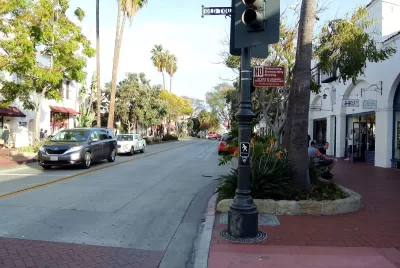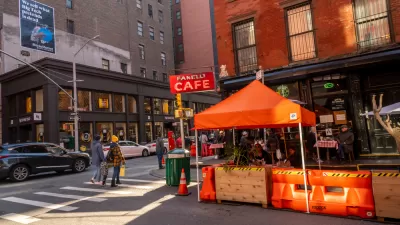The city will consider adjustments to its outdoor dining policy after the fire department expressed concerns about access for emergency vehicles.

Social distancing restrictions imposed during the pandemic forced cities to rapidly implement outdoor dining programs, and Santa Barbara, with its bustling downtown restaurant scene, was no exception. Now, at the Fire Department's request, the city may remove or alter around 25 outdoor seating areas approved under the COVID-19 program. As John Palminteri reports, "The Santa Barbara City Fire Department says it needs 20-feet down the middle of the street in the area where they only have a space of 14 and a half feet," a number that the fire department previously agreed to.
The city is now evaluating the regulations for its outdoor dining program and plans to amend the rules to address concerns from first responders, business owners, and local residents, as well as other design changes for the city's downtown.
Although the concept of parklets—public or private seating or dining areas created from curbside or surface parking—has been around for years, COVID-19 led to an explosion of "pandemic dining" projects, with cities scrambling to create regulations and balance the need for more outdoor dining and seating with traditional street uses and user safety concerns. Cities around the country embraced "al fresco dining" and "open streets," inadvertently creating models for what could be permanent fixtures of future cities, where street space is reimagined to serve a broader segment of users and purposes.
FULL STORY: Many parklets and patios could be cut back in the Santa Barbara promenade by early March

Alabama: Trump Terminates Settlements for Black Communities Harmed By Raw Sewage
Trump deemed the landmark civil rights agreement “illegal DEI and environmental justice policy.”

Study: Maui’s Plan to Convert Vacation Rentals to Long-Term Housing Could Cause Nearly $1 Billion Economic Loss
The plan would reduce visitor accommodation by 25% resulting in 1,900 jobs lost.

Why Should We Subsidize Public Transportation?
Many public transit agencies face financial stress due to rising costs, declining fare revenue, and declining subsidies. Transit advocates must provide a strong business case for increasing public transit funding.

Paris Bike Boom Leads to Steep Drop in Air Pollution
The French city’s air quality has improved dramatically in the past 20 years, coinciding with a growth in cycling.

Why Housing Costs More to Build in California Than in Texas
Hard costs like labor and materials combined with ‘soft’ costs such as permitting make building in the San Francisco Bay Area almost three times as costly as in Texas cities.

San Diego County Sees a Rise in Urban Coyotes
San Diego County experiences a rise in urban coyotes, as sightings become prevalent throughout its urban neighbourhoods and surrounding areas.
Urban Design for Planners 1: Software Tools
This six-course series explores essential urban design concepts using open source software and equips planners with the tools they need to participate fully in the urban design process.
Planning for Universal Design
Learn the tools for implementing Universal Design in planning regulations.
Smith Gee Studio
Alamo Area Metropolitan Planning Organization
City of Santa Clarita
Institute for Housing and Urban Development Studies (IHS)
City of Grandview
Harvard GSD Executive Education
Toledo-Lucas County Plan Commissions
Salt Lake City
NYU Wagner Graduate School of Public Service





























